Food is more than eating. It’s history and heritage, culture, recipes, techniques, produce, and deliciousness. In 1998, as a geology student at the University of Liverpool in the U.K., I was homesick and began to cook Nigerian food as though my life depended on it. In 2009, working in the Netherlands, writing about food became a way to remember home differently, fondly—to celebrate even things I couldn’t stand about it, like overfriendliness and not-minding-your-own business-ness. This exploration led me to many discoveries. The most fascinating were the similarities between Nigerian and global cuisines, a revelation that eased some of the pain inside.
I’ve always loved Nigerian food but had no reason to celebrate it. Like I did with my parents when I was young and carefree, I took it for granted, assuming it would always be there, within comfort’s reach. Then I moved away, and my food culture became the stuff of memories.
I missed everything about Nigerian food. I missed the interesting mélange of rich, vibrant stews, porridges, and pottages. I missed the aromatic and the pungent, the dishes full of umami and smoke, the complex spicy, bitter, and sour flavors. I missed all of it. Most of all, I missed seasonal produce, from the sweet and sour African white star apples, which appeared with the first rains in December, to the juicy mangoes in February and the rainy-season fruits—passion fruit, corn, ube (African purple pear), and more.
I learned that a lot of our dishes are surf and turf, combining the best of sea and land. I found it interesting that our crayfish—dried and ground for seasoning—is used much the way fish sauce and shrimp paste are in Southeast Asian cuisine. There’s a depth of flavor brought by crayfish, as well as other smoked and fermented elements like nuts and seeds. And, as in many parts of Asia, various palms feature, such as coconut, date and palm nut, from which the bright red-orange, beta carotene–rich palm oil is culled.
Regional variation is shaped by geography and religion. For instance, the cuisine of the predominantly Muslim north is dairy-rich and exhibits Arabic influence. Grilled meats, flatbreads, and spiced teas are common, as well as cereals and grain (rice, millet, sorghum, etc.). In the south and western (coastal) regions, some Christians shun pork, but the meat is still common—often grilled, smoked, or deep-fried. Seafood and tropical palms like coconut abound as well as rice, yams, and plantains. Inland to the east, typical tubers and pulses include cassava, bambara groundnuts, and breadfruit.
The slave trade and colonization left their mark on our cuisine. The Portuguese introduced cassava, for example. British colonialists brought spices from India. One thing I know to be homegrown is the love for protein—meat, seafood, and everything in between. Every cut from nose to tail is prized and features in delicacies, very much like the Italian cucina povera, or “peasant cooking” style, which wastes not.
There are so many dishes that have shown me the ways we are similar across the world, even in the thick of our differences.
Akara

Akara are fritters made from blending raw, skinned black-eyed peas with onions and chili. The mix is seasoned with salt before it’s shaped into a ball and deep-fried. Akara are similar to Middle Eastern falafel and hush puppies of the American South, and they are popular in home kitchens and on the street.
Growing up, my mum made them for breakfast on Saturdays. We fashioned akara burgers from chunks of soft, white, unsliced bread, torn by hand and uncorrupted by silverware, then folded over the fritters. If you wanted, she would serve your akara with akamu, a slightly sour, fermented cornstarch pap served with milk and sugar.
On street corners, early in the morning and late in the evening, you will find akara made and sold by elderly women, or Mamas. They set up an entire production facility with bubbling pans of oil (vegetable, palm, or a mix); wooden mortars and pestles, wielded like whisks to whip air into the mix; slotted spoons and strainers to save the akara from drowning and burning in oil; and trays to lay out the wares. Quite often these Mamas also offer small loaves of bread, as well as fried yams, sweet potatoes, and plantains with pomo (cowhide) in ata dindin (fresh pepper sauce)—all of which create the ultimate street-food feast.
Bean fritters are common around the world, from the bhajias of Tanzania to the taamiyas of Egypt, but the fava bean fritters of Oman and the Middle East are the most fascinating to me.
And then there’s acarajé, akara’s Brazilian twin. A specialty of the northeastern city of Bahia in Salvador, it journeyed in the hearts and minds of enslaved West Africans in the 19th century. The significance of acarajé’s heritage stuns me: Enslaved people held onto the memories of food from their homelands. In spite of despair and depression, they re-created, enshrined, and served up their past in acarajé. It gives a whole new meaning to the term “comfort food.”
Pepper soup
When we speak of soups in Nigeria, we’re either referring to pepper soup—our only drinking soup—or to preparations that are technically stews (egusi, okro, and the like).
Pepper soup is Nigeria’s version of chicken soup. It is simultaneously a celebration dish and our cure-all for every ailment, from fever to flu. It can be breakfast, lunch, dinner, party starter, and everything in between. In concept and flavor, it is similar to Thai tom yum, Vietnamese pho, and other chicken soups around the world.
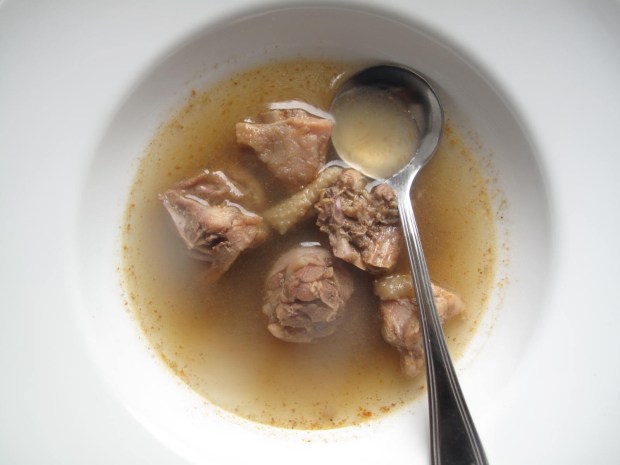
The name “pepper soup” is a touch misleading, because it isn’t always peppery. Spicy? Yes, usually, but the spice speaks to multiple dimensions of flavor—nutty, earthy, and bitter with heat; it’s much more than just heat by itself. For too long Nigerian food has been dismissed as being too hot, too peppery, and therefore undesirable. I fear that recipe names have caused many to misjudge our cuisine. After all, who wants to eat a meal that’s no more than one ingredient?
What is it then? Pepper soup is an aromatic broth composed of fragrant spices and herbs. The flavor base is a blend of indigenous spices (calabash nutmeg, grains of selim, and more) combined with fresh herbs (lemon grass, scent leaves, lime leaves) and protein (seafood, beef, goat, or poultry). These proteins can be fresh or smoked and dried; other times roots, tubers, and vegetables are added in or served as a side. Pepper soup is definitely one of my favorite dishes—it is definitely comforting!
Egusi Soup
Lunch or dinner might be egusi or some other soup that is really a stew in other cultures. In Nigeria, “stew” is almost always red—often made with tomatoes, blended with onions and peppers, and cooked down until thick. In some cases palm oil supplements or replaces the red of the tomatoes, like in ofada stew, a rich, spicy dish made with green peppers and onions.
Though stews are generally defined as slow-cooked mixtures of meat and vegetables, we call them soups. We begin with cooked meats in a seasoned base, flavored with dried, ground crayfish. This touch adds complexity to the dish as well as pungency and umami. Thickeners are then added, varying widely from nuts to legumes or greens.
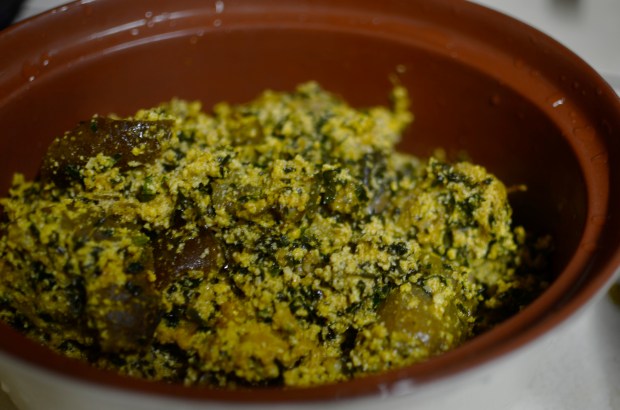
Egusi is cooked in a seasoned stock of oil, ground melon seeds, and leafy greens. The result is a thick, creamy soup with chunks that have a curd-like texture. One might serve egusi with a variety of stiff, doughy sides, like eba or cassava meal. The eba, like other starches, serves as both spoon and scoop. Approach the mass with four fingers (generally using your right hand—in some places understood as the respectful thing to do), and tear off small bites to dip into the soup. Yum!
Stew

So what do we call stew? Well, think of it as a sauce made of a blend of our holy trinity—fresh tomatoes, red onions, and peppers—cooked with vegetable or palm oil and often meat or seafood.
Traditional pots of stew are seasoned with fermented locust beans, which have the pungency of Danish blue cheese. Regular versions feature West Indian–style curry powder—a legacy of colonial Britain—dried thyme, garlic, ginger, bay leaves, tomato paste, and stock cubes. In fact, this combination is the base of a lot of the dishes that come out of the Nigerian kitchen. Sometimes the stew base sports red onions and peppers without tomatoes. Most times the mix is blended before being cooked down, to reduce the volume while taking the edge off the flavor.
Jollof Rice
At the heart of jollof rice—a spiced red rice popular south of the Sahara and all along the coast of West Africa—is the Nigerian tomato stew. If you can try one dish and only one, I suggest you make it jollof with dodo (fried plantains) and your choice of meat or seafood.
Invented by the Senegalese and named after the Jolof Kingdom centuries ago, Nigeria has earned rights to the dish by creating some of the finest pots of jollof ever. In Nigeria, there is regular jollof, and there is the gold standard of all jollofs, known simply as “party rice.” Smoky and delicious, it is the specialty offering at celebratory events. Would you believe that some people attend parties purely for the jollof? When you taste it, you’ll understand why.
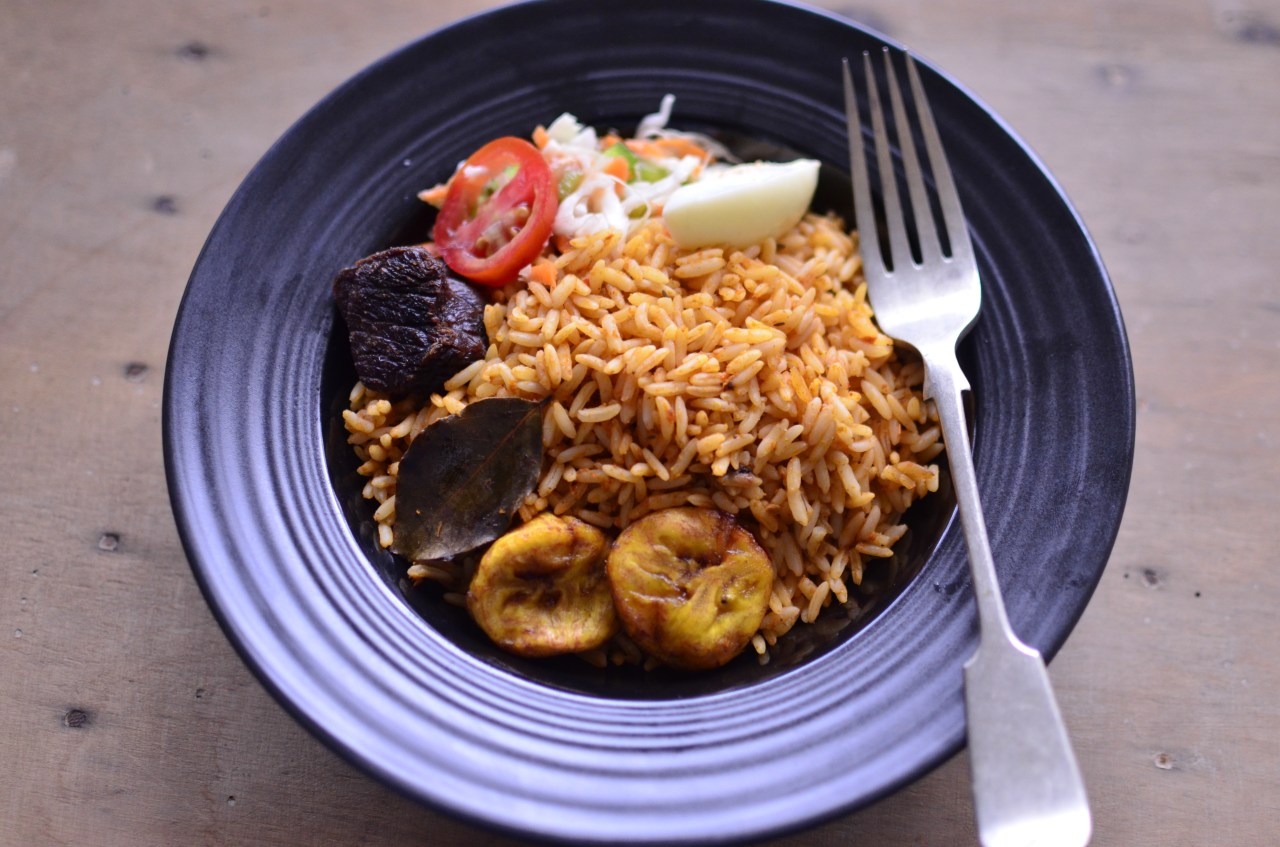
Jollof is really rice perfection, halfway between the dryness of pilaf and the creaminess of risotto. Traditionally, raw or parboiled long-grain rice is cooked in a red tomato stew with meat or vegetable stock and seasoned with curry powder, thyme, bay leaf, etc. When properly cooked, the flavors create a smoky, rich, multilayered, and satisfying dish.
Over the last few years jollof has risen to global prominence on account of the jollof wars. Banter and rivalry between Nigeria and Ghana have led to contests, festivals, cook-offs, and writing around the world. In spite of the jollof wars, Nigeria and Ghana come together on occasion in defense of jollof. In 2014 the two countries set aside their jollof enmity to protest a version of jollof they considered a travesty. Cooked by chef Jamie Oliver, the outrage spawned the hashtag #Jollofgate. Oliver’s “jollof” didn’t look and probably didn’t taste like jollof, and it featured lemon and parsley as well as whole tomatoes—none of which is a jollof regular. And though Oliver was clear that this was his version of the dish, West Africans were not having it.
Puff-Puff
The first time I encountered puff-puff by a different name was in 2008, the year after I moved to Wassenaar, in the Netherlands. One fine day in April, Koninginnedag (Queen’s Day), I was walking down Langstraat (High Street), and the scent of something familiar, warm, and comforting drew me to a stand where a gentleman stood flipping balls of dough in oil. One bite of the raisin-studded dough and I exclaimed in rapturous delight, “This is puff-puff!” But these were oliebollen, oil balls formed with ice-cream scoops or spoons, sold at fetes and festivals, and most often consumed during the winter.
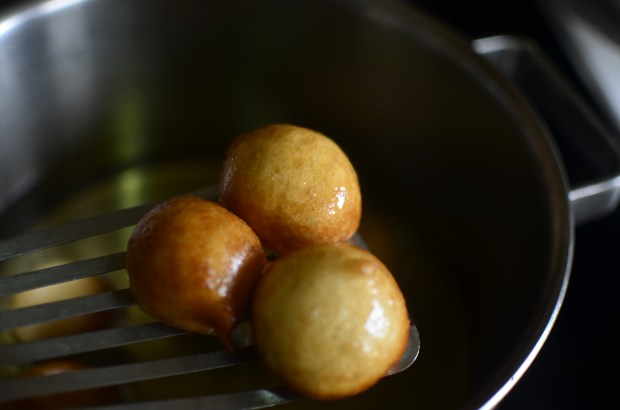
In Nigeria, we enjoy puff-puff with a crunchy shell and chewy center, particularly in “small chops,” the army of bite-size snacks put out at special events. I first encountered puff-puff at a wedding; they were keeping company with spring rolls, samosas, and flour-dusted, deep-fried whitebait (small, silvery fish no longer than a finger). The combination of soft, pillowy fried dough and crisp fish and pepper sauce was heavenly and prompted a lifelong commitment to fried-dough consumption.
From Ghanaian bofrot (ball floats) to East African mandazi and South African koeksisters, every cuisine has some form of fried dough. There’s Italian zeppole, syrup-soaked Indian gulab jamun, dough cousins Turkish lokma and Greek loukoumades. I understand that in Latin America the buñuelo is popular from Argentina to Venezuela, often filled or topped. Germany has fasnacht, the Middle East awamat. From France to New Orleans in the American South, the beignet is king.
There are many differences among them: The liquid used in the dough can be water, milk, beer, or, in Nigeria, palm wine; and the add-ins can be nuts or dried fruit. No matter the thickness or how they are finished—plain, glazed, or rolled in sugar and spice—they are all part of the same happy fried family.
Suya
Suya is an institution in Nigeria.
What is suya? Generally, grilled strips of beef coated in yaji. This combination of ground peanuts, kuli kuli with the oil extracted, and other ground spices—red chilli powder, ground ginger, garlic, and onions—works as both tenderizer and flavor maker. As one can imagine, every mallam, or “suya man,” has his own special blend. In Ghana tankora is a similar spice blend, adding toasted cornmeal to the ground peanuts and spice.
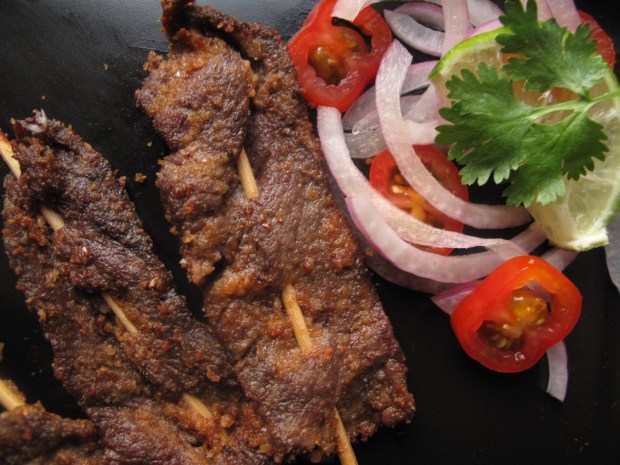
In the past suya was never made at home. It was, after all, affordable, and you were never far from a mallam. That is, except when you were away from home, hankering after the spicy meats of your country of birth. Then and only then would it make sense to cook suya at home. Today things have changed, thanks to a growing desire to know more about Nigerian cuisine and culture. People now buy yaji and make suya from scratch. Still, it is and always will be a treat.
Once cooked, suya becomes this happy union of heat and spice, smoke and umami, sour and bitter, in an altogether delicious beef skewer, coated in a spicy, peanutty rub and grilled over coals. But that’s only one half of it. The other? Serving it with slices of fresh tomato, onions, and chilies. Lately I enjoy mine with the regular fixings as well as some nontraditional cilantro and lime.
Chapman

I’d been drinking Chapman for most of my life, but it wasn’t until I went home on holiday from university in Liverpool that I learned to make the deep red, refreshing drink. Absence did make my heart grow fonder—and my head wiser. I got the recipe off a bartender and have never forgotten it. I also learned that this is a unique Nigerian drink.
Chapman is one of those mocktails that, like shandy, skirt the boundary between youth and adulthood. Something about the bitters, the dimpled pint glass often reserved for ale and lager, and the very interesting name makes the drink seem grown-up even without the alcohol. I’ve always found the name fascinating. The Free Dictionary defines Chapman as a peddler or, in archaic English, a dealer or merchant. How that became the name of this drink, I have no idea. Some say the drink was named by colonial Brits sitting at the bar of the Ikoyi Hotel, where a Nigerian hospitality expert, Sam Alamutu, invented it in pre-Independence Lagos.
Chapman is a mix of orange and lemon-lime sodas, blackcurrant cordial (cassis) or grenadine, and a dash of bitters. On ice it is incredibly refreshing, but I love its versatility. I’ve made it in punch bowls. I’ve steeped slices of cucumber and citrus in it sangria-style. I’ve served it to children. I’ve also boozed it up with Campari for adults.
We love Chapman, and these days I make my version with locally brewed bitters and a homemade hibiscus cordial heavy with ginger notes. The deliciousness is the same, if not better. Chapman is a champ of a drink.